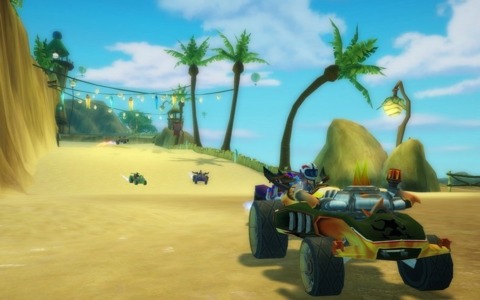Free Realms PS3 due mid-2010, EyeToy support 'likely'
GDC Austin 2009: John Smedley explains how SOE's brave new MMO world--for kids!--has cracked the massively multiplayer gender barrier.
Who Was There: John Smedley, president of Sony Online Entertainment, delivered the opening keynote address of the Austin Game Developers Conference 2009. The keynote address took the form of a postmortem of sorts on Free Realms, the company's first massively multiplayer online game for younger audiences.

What They Talked About: John Smedley took the stage to the sound of The Cars' hit, "You Might Think I'm Crazy," a nod to the executive's faith in Free Realms, which is a microtransaction-driven MMOG for kids. That audience's members, of course, lack access to their own credit cards.
Smedley talked about the inspiration for Free Realms. The process started when SOE looked at a breakdown of the MMOG audience, which the company had pegged as 85 percent male with an average age of 33. Free Realms was designed from the start with the goal of expanding the MMOG audience, and it's done so quickly and efficiently. Since Free Realms launched in April, Smedley said the game achieved 5 million users last month.
Making a game for kids is worlds different from making a standard MMOG, something that SOE understood going into the project back in 2005. One way the company got a glimpse into how kids differed from adult players was with usability labs. These involved elaborate play-testing scenarios where developers videotaped kids playing early versions of the game from a number of angles. They zoomed in to see the kids' faces and mouse clicks.
The developers gleaned a wealth of observations from those labs. Notably, kids have incredibly short-attention spans--somewhere in the realm of five minutes--with an average play session lasting only 20 minutes. That's a pretty broad lesson, but Smedley said developers learned some very specific lessons from the labs as well.
The team found that kids were having problems making it past the game's registration screen, which asked for a country, name, and date of birth. Smedley explained that some 60 percent of children don't know what year they were born. However, they know how old they are, so SOE switched the registration to ask for an age instead of a birth date.
Smedley also touted the gender breakdown of Free Realms players as evidence their approach to designing the game paid off. While SOE hasn't reached its goal of having a user base split evenly down the middle between boys and girls, the 33 percent female population of Free Realms shows that girls will play an MMOG if you design it properly.
Smedley said one key for any girl-friendly MMOG is to have a wide variety of activities, with combat being just one strictly optional part of gameplay. Smedley said activities like cooking, pet training, and mining (a job that levels up with play of a match-three puzzle game) have proven popular with girls. The developers are also putting more minigame activities for boys into Free Realms, with kart racing and trading card dueling games built into the MMOG world as well.
In a few weeks, SOE will also launch a soccer game in Free Realms. Smedley said the new game should help with the international appeal of Free Realms (recently released in French, Spanish, and other languages) and uses an activity kids are already familiar with.
One problem with having a microtransaction-driven MMOG with 80 percent of its audience under the age of 18 is that you have to sell the program to the users and their parents, Smedley said. Prepaid cards at retailers have helped, and the store has been tweaked a number of times to make it less confusing to kids.
The biggest surprise to the developers is that while two-thirds of the audience is made up of boys, two-thirds of the purchasers are girls. Trading card packs for the dueling minigame are the top-selling item, but healing potions and pets have also been big sellers. SOE is now putting in online retailer-style recommendations based on the players' in-game jobs and interests.
The experience with Free Realms has also taught SOE a lot about marketing to kids. Smedley said TV spots on Cartoon Network and Nickelodeon have been hugely important, and 75 percent of the game's traffic is driven by TV. The company has also found that if you're not constantly reminding kids of the game with TV ads, they tend to move on to something else.
Despite the learning curve, Free Realms has been a success for SOE, Smedley said. The company is so pleased with the product that it's preparing another product along the same audience-expanding lines, although the executive wouldn't offer any details on that project.
SOE isn't done with Free Realms yet, either. Smedley reiterated plans to bring the game to the PlayStation 3 toward the middle of 2010 and said it's "very likely" that the game will support the EyeToy peripheral when it arrives on the console.
Quote: "There are some upsides to kids. They don't call customer service, almost ever. And they don't talk on the forums."--Smedley jokes about the upside to Free Realms' nontraditional MMOG user base.
Takeaway: Making online games for kids is difficult, Smedley said, but there are big rewards for people who are able to crack the market.
Got a news tip or want to contact us directly? Email news@gamespot.com
Join the conversation